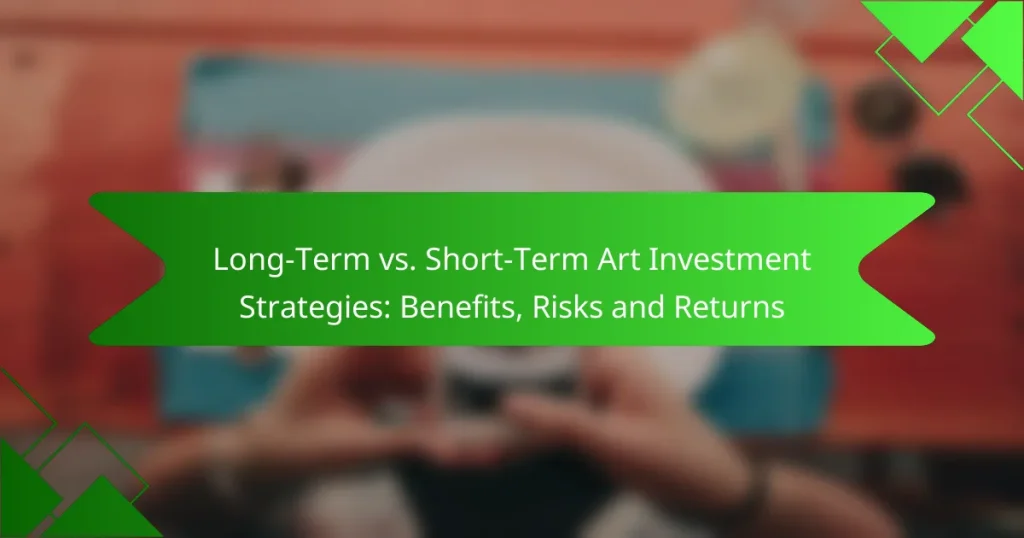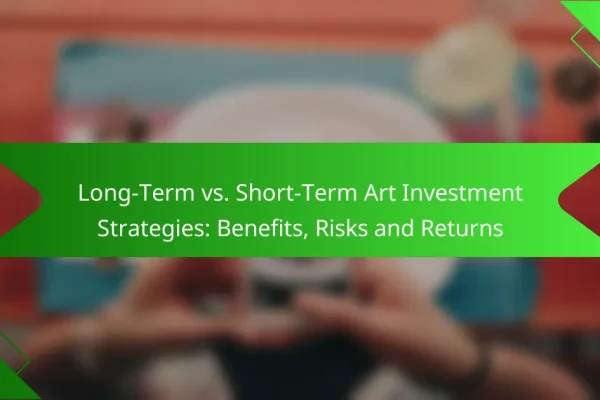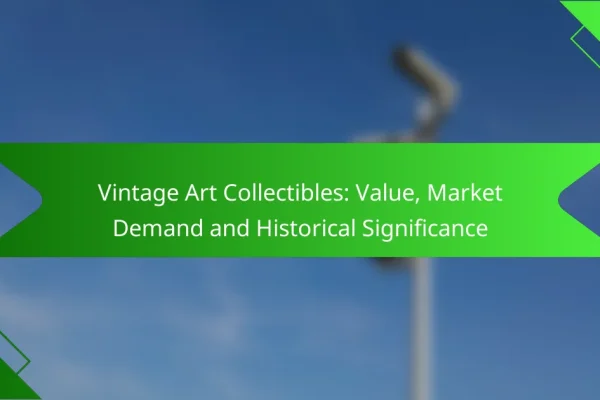
Long-Term vs. Short-Term Art Investment Strategies: Benefits, Risks and Returns
Investing in art can take various forms, with long-term and short-term strategies each offering unique…
Starting an art collection can be an enriching experience, but it requires careful consideration of your preferences and budget. By exploring local galleries, art fairs, and collector groups, you can enhance your knowledge and network within the art community. Key factors such as authenticity, artist reputation, and market trends are essential for making informed decisions and building a valuable collection.

Investing in art can take various forms, with long-term and short-term strategies each offering unique benefits and risks. Long-term art investments often promise significant appreciation in value and emotional fulfillment, but they also come with challenges such as market volatility and illiquidity. Understanding these dynamics is crucial for investors looking to navigate the art market…

Art insurance is essential for protecting valuable artworks and collectibles from risks like theft, damage, or loss. Various coverage types, including fine art, collectibles, and liability insurance, cater to different needs, ensuring that each piece is adequately protected. Proper valuation methods are crucial for determining the worth of art, while understanding the claims process can…

Art collecting clubs present a unique opportunity for enthusiasts to deepen their engagement with the art world while reaping numerous benefits. Members gain access to exclusive events, valuable expertise, and enhanced networking opportunities that can lead to significant investment potential. Through collaboration, these clubs facilitate joint purchasing, co-hosted events, and resource sharing, enriching the overall…

The historical context of art significantly enhances the understanding and appreciation of artworks, revealing the cultural, social, and political influences that shaped their creation. This context not only enriches the viewer’s experience but also plays a vital role in determining the market value of a piece, as factors like the artist’s background and the era…

Vintage art collectibles are highly sought after for their unique blend of aesthetic appeal and historical significance, with their value influenced by factors such as rarity, condition, and provenance. The market demand plays a crucial role in determining prices, as collectors are often willing to pay a premium for pieces that resonate with cultural and…

For new art collectors in the US, a wealth of resources is available to help navigate the art market effectively. From online platforms and local galleries to informative blogs, these tools can guide you in identifying your interests, setting a budget, and making informed purchases. By utilizing art valuation apps and inventory management software, you…

The art markets in North America and Europe exhibit distinct trends influenced by cultural and economic factors. North America is experiencing a rise in digital platforms and contemporary art, while Europe maintains a strong emphasis on traditional art forms and auction house performance. Understanding these differences is crucial for collectors and investors navigating the evolving…

Diversity plays a crucial role in enhancing market value by fostering innovation and appealing to a wider range of consumers. As organizations increasingly prioritize equitable environments that reflect diverse backgrounds, they not only drive financial success but also strengthen their connections with customers. By leveraging varied perspectives, businesses can create innovative solutions and enhance their…

The debate between fine art and decorative art collectibles often hinges on value, functionality, and personal preference. Fine art typically offers higher long-term appreciation and prestige, making it a strong investment choice for collectors seeking unique assets. In contrast, decorative art provides accessible beauty and functionality, ideal for those looking to enhance their living spaces…

Creating an art collecting network in major cities is essential for connecting with local artists, galleries, and fellow collectors, fostering a vibrant community. This network not only enhances your art collection experience but also provides valuable resources for discovering and acquiring unique artworks. By actively engaging with various platforms and participating in art events, you…
Starting an art collection in the UK involves understanding your preferences, setting a budget, and exploring various avenues to acquire artworks. Focus on local galleries, art fairs, and collector groups to build your knowledge and network.
Local galleries are essential for discovering emerging artists and unique pieces. Visit galleries in your area to familiarize yourself with different styles and mediums, and take note of artists whose work resonates with you.
Many galleries offer exhibitions and events that provide insights into the art market. Engaging with gallery owners and curators can also help you understand pricing and the value of artworks.
Art fairs are excellent opportunities to see a wide range of artworks from various artists and galleries in one place. These events often feature established and emerging talents, allowing you to compare styles and prices easily.
When attending art fairs, prepare to ask questions and take notes. This can help you gauge the market and identify pieces that fit your collection. Be mindful of your budget and consider setting a spending limit before you go.
Joining art collector groups can provide valuable networking opportunities and insights into the art world. These groups often host events, discussions, and exhibitions that can enhance your understanding of art collecting.
Participating in these communities can also help you connect with other collectors who share your interests. They can offer advice on purchasing, selling, and maintaining your collection, as well as share information about upcoming events and exhibitions.
When collecting art, key factors include budget allocation, art authenticity, and artist reputation. Understanding these elements can help you make informed decisions and build a valuable collection.
Establishing a budget is crucial before starting your art collection. Determine how much you are willing to spend overall and allocate funds for individual pieces, taking into account additional costs like framing, insurance, and maintenance.
Consider setting a range for each artwork, which can vary widely based on the medium, artist, and market demand. For example, emerging artists may offer pieces in the low hundreds to low thousands of USD, while established artists can command prices in the tens of thousands or more.
Ensuring the authenticity of art is vital to protect your investment. Always seek documentation, such as certificates of authenticity or provenance records, which provide a history of the artwork and verify its legitimacy.
Be cautious of forgeries, especially in high-value markets. Engaging with reputable galleries or auction houses can help mitigate risks, as they often have established processes for verifying authenticity.
The reputation of an artist can significantly influence the value of their work. Research the artist's background, previous exhibitions, and sales history to gauge their standing in the art community.
Consider investing in works by artists who have shown consistent growth in recognition and demand. Emerging artists may offer lower prices, but their potential for future appreciation can be substantial if they gain prominence.
To evaluate the value of an artwork, consider factors such as market trends, provenance history, and condition reports. These elements help determine both the monetary worth and the cultural significance of the piece.
Market trends reflect the current demand and pricing for specific types of art. Changes in popularity can significantly affect an artwork's value, with contemporary pieces often experiencing rapid fluctuations compared to classical works.
Monitoring auction results, gallery sales, and online platforms can provide insights into which artists or styles are gaining traction. For instance, works by emerging artists may sell for lower amounts initially but can appreciate quickly if they gain recognition.
Provenance history refers to the documented ownership of an artwork, which can greatly influence its value. A well-documented provenance can enhance an artwork's desirability, especially if it has been owned by notable collectors or displayed in prestigious exhibitions.
When evaluating provenance, consider factors such as the artwork's exhibition history, previous sales, and any relevant documentation. A piece with a clear and reputable lineage is often valued higher than one with an unclear history.
Condition reports assess the physical state of an artwork, detailing any damage or restoration work. The condition can significantly impact value, as pieces in excellent condition typically command higher prices than those with visible wear or damage.
When evaluating an artwork, obtain a professional condition report to understand its current state. Look for issues like fading, cracks, or repairs, and factor these into your valuation. Regular maintenance and proper storage can help preserve an artwork's condition over time.
Best practices for art preservation include maintaining proper lighting, controlling the climate, and conducting regular maintenance. These practices help ensure the longevity and integrity of artworks, protecting them from damage caused by environmental factors.
Proper lighting is crucial for art preservation as it can prevent fading and deterioration. Use UV-filtered lights and avoid direct sunlight exposure, which can cause significant damage over time. Aim for ambient lighting levels that are low to moderate, typically between 50 to 200 lux, depending on the type of artwork.
Consider using LED lights, as they produce less heat and UV radiation compared to traditional bulbs. Regularly assess the lighting conditions to ensure they remain within safe limits for your specific art pieces.
Climate control is essential for preserving artworks, as temperature and humidity fluctuations can lead to damage. Ideally, maintain a stable temperature between 18-22°C (64-72°F) and humidity levels around 40-60%. This range helps prevent mold growth and material degradation.
Invest in a reliable HVAC system and use dehumidifiers or humidifiers as needed. Regularly monitor the environment with hygrometers and thermometers to ensure conditions remain optimal for preservation.
Regular maintenance of art pieces is vital for their longevity. This includes dusting, cleaning, and inspecting artworks for signs of damage. Use soft, lint-free cloths for dusting and avoid harsh chemicals that could harm the surface.
Establish a maintenance schedule based on the type of artwork and its specific needs. For example, paintings may require more frequent checks than sculptures. Document any maintenance performed to track the condition and care of each piece.
Insuring an art collection involves assessing its value and selecting the right coverage to protect against loss or damage. It's essential to work with professionals who understand the nuances of art insurance to ensure comprehensive protection.
Engaging with insurance specialists who focus on art collections is crucial. They can provide tailored advice based on the specific types of artwork you own, whether it be contemporary pieces or historical artifacts.
Look for agents who have experience in the art market and can help navigate the complexities of insuring high-value items. They will understand the unique risks associated with art, such as theft, fire, and environmental damage.
Accurate documentation of appraisals is vital for insuring an art collection. Regular appraisals help establish the current market value of your pieces, which is necessary for determining the appropriate coverage amount.
Consider obtaining appraisals from certified professionals who specialize in art. Keep records of these appraisals, as they can be crucial in the event of a claim, ensuring you receive adequate compensation for any loss.
Art insurance policies can vary significantly, so it's important to understand the different options available. Policies may cover loss, theft, damage, and even restoration costs, but the specifics can differ widely.
Review the terms carefully, focusing on exclusions and limitations. For instance, some policies may not cover certain types of damage or may have specific conditions for high-value items. Compare multiple quotes to find the best coverage that suits your collection's needs.
Emerging trends in art collecting include the rise of digital art and non-fungible tokens (NFTs), as well as a growing focus on sustainability and diversity in art. Collectors are increasingly looking for innovative ways to invest in and showcase their collections, often blending traditional and contemporary methods.
Digital art and NFTs represent a significant shift in the art market, allowing artists to create and sell works in entirely new formats. NFTs are unique digital assets verified using blockchain technology, which ensures ownership and provenance. This has opened up new opportunities for both artists and collectors.
When considering digital art and NFTs, collectors should evaluate the platform used for purchase, the artist's reputation, and the rarity of the piece. Prices for NFTs can vary widely, often ranging from a few hundred to millions of dollars, depending on the artist and market demand.
Collectors should be cautious of potential pitfalls, such as market volatility and the risk of scams. It's advisable to conduct thorough research and only invest in well-established platforms. Additionally, keeping abreast of technological advancements and trends in the digital art space can help collectors make informed decisions.